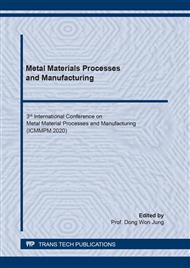[1]
V. K. Jain, K. K. Saren, V. Raghuram and M. Ravi Sankar, Force analysis of magnetic abrasive nano-finishing of magnetic and non-magnetic materials, Int. J. Adv. Manuf. Technol. 100 (2019) 1137–1147.
DOI: 10.1007/s00170-016-8954-0
Google Scholar
[2]
J. S. Kwak, Mathematical model determination for improvement of surface roughness in magnetic-assisted abrasive polishing of nonferrous AISI316 material, Trans. Nonferrous. Met. Soc. China 22 (2012) s845−s850.
DOI: 10.1016/s1003-6326(12)61814-7
Google Scholar
[3]
T. Shinmura, K. Takazawa, E. Hatano, M. Matsunaga and T. Matsuo, Study on Magnetic Abrasive Finishing, CIRP Annals, 39(1) (1990) 325-328.
DOI: 10.1016/s0007-8506(07)61064-6
Google Scholar
[4]
T. Shinmura, K. Takazawa, E. Hatano, Study on magnetic abrasive process -Application to plane finishing-, Bull. Jpn. Soc. Precis. Eng. 19 (4) (1985) 289-294.
Google Scholar
[5]
A. Misra, P. M. Pandey, U. S. Dixit, Modeling and simulation of surface roughness in ultrasonic assisted magnetic abrasive finishing process, Int. J. Mech. Sci. 133 (2017) 344–356.
DOI: 10.1016/j.ijmecsci.2017.08.056
Google Scholar
[6]
Y. H. Zou, A. Y. Jiao, T. Aizawa, Study on Plane Magnetic Abrasive Finishing Process - Experimental and Theoretical Analysis on Polishing Trajectory -, Advanced Materials Research 126 (2010) 1023-1028.
DOI: 10.4028/www.scientific.net/amr.126-128.1023
Google Scholar
[7]
A. Y. Jiao, H. J. Quan, Z. Z. Li, Y. H. Zou, Study on improving the trajectory to elevate the surface quality of plane magnetic abrasive finishing, Int. J. Adv. Manuf. Technol. 80(9-12) (2015) 1613–1623.
DOI: 10.1007/s00170-015-7136-9
Google Scholar
[8]
P. Kala, V. Sharma, P. M. Pandey, Surface roughness modelling for double disk magnetic abrasive finishing process, Journal of Manufacturing Processes 25 (2017) 37-48.
DOI: 10.1016/j.jmapro.2016.10.007
Google Scholar
[9]
M. Feng, Y. B. Wu, Y.L. Wang, J. Zeng, et al. Investigation on the polishing of aspheric surfaces with a doughnut-shaped magnetic compound fluid (MCF) tool using an industrial robot, Precision Engineering 61 (2020)182-193.
DOI: 10.1016/j.precisioneng.2019.09.018
Google Scholar
[10]
M. Feng, Y. B. Wu, Fundamental investigation on the polishing aspheric elements with doughnut-shaped MCF slurry, Key Eng. Mater. 792 (2018) 179–84.
DOI: 10.4028/www.scientific.net/kem.792.179
Google Scholar
[11]
Y. H. Zou, H. J. Xie, C. W. Dong, J. Z. Wu, Study on complex micro surface finishing of alumina ceramic by the magnetic abrasive finishing process using alternating magnetic field, Int. J. Adv. Manuf. Technol. 97(5-8) (2018) 2193-2202.
DOI: 10.1007/s00170-018-2064-0
Google Scholar
[12]
H. J. Xie, Y. H. Zou, C. W. Dong, J. Z. Wu, Study on the magnetic abrasive finishing process using alternating magnetic field: investigation of mechanism and applied to aluminum alloy plate, J. Adv. Manuf. Technol. 102(5-8) (2019) 1509-1520.
DOI: 10.1007/s00170-018-03268-8
Google Scholar


